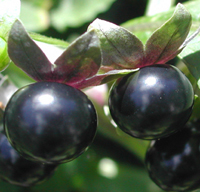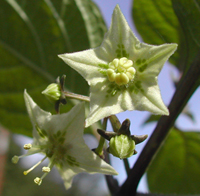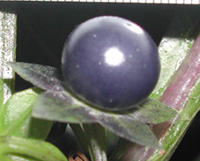Jaltomata (Solanaceae) of Arizona, USA, Mexico and Central America |
revised 13 Oct 2014 |
The information on this page may be cited as a communication with professor Thomas Mione, Central Connecticut State University,
Biology Department, Copernicus Hall, 1615 Stanley Street, New Britain, CT 06050-4010 |
All species are protogynous (pistillate before becoming hermaphroditic) with one exception: J. darcyana is hermaphroditic when it opens.
Fruits are purple/black with a few exceptions: fruits that are green at maturity have been documented on some accession of J. chihuahuensis and some accessions of J. procumbens.
|
|
species |
diagnostic characteristics |
distribution |
calyx with fruit |
 |
|
|
widespread & common Arizona, USA to Ecuador |
 |
 |
|
- undehisced anthers of a flower vary in size (photo at left)
- filaments curved to sigmoid (evident after filaments elongate and therefore not shown in photo at left)
- style curved
- fruit remains attached after ripening
|
widespread & common, Mexico to Bolivia |
 |
 |
|
- hirsute
- filaments usually do not angle out (photo at left), but when they do, they do not angle out more than 15 degrees
- 5-lobed corolla
- fruits partially hidden in side view by the calyx which remains green (photo at right)
- fruits drop at maturity
|
northern Mexico |
 |
 |
|
- flowering calyx to 7.5 mm in diameter
- calyx lobes recurved both lengthwise and in cross section (photo at right)
- corolla 5-lobed (photo at left)
- fruiting calyx recurved (photo at right) and lobe radius to 6 mm
|
endemic to Mexico, Mexico |
 |
 |
|
- mature plant glabrous except for lower half of filaments which are pubescent
- stems having projecting acute-angled longitudinal ridges
- corolla has 5 lobules in addition to 5 lobes
- fruiting calyx an inverted funnel hiding the berry in side view (photo to right)
|
endemic to one high-elevation area of Oaxaca, Mexico |
 |
| |
|
|
endemic to one cloud forest area of Chiapas, Mexico |
 |
 |
|
- densely velutinous
- peduncle shorter than 11 mm
- corolla 34 - 38 mm in diameter (hermaphroditic state)
- undehisced anthers longer than 2.8 mm
- stigma large: 1.0 by 1.5 mm in overhead view.
- large pollen 42.5 - 46.25 µm diameter
- fruit large
|
endemic to one area of Michoacan, Mexico |
 |
| |
|
- 2 - 3 flowers per inflorescence
- leaves small, 1.5 - 3.5 cm long
|
Guatemala |
|
| |
|
|
Guatemala |
|
| |
|
- leaves very large and somewhat leathery
- style curved
- lacking a pistillate phase
|
Mexico and Costa Rica, probably also between |
 |
Key To The Jaltomata species of Mexico
The following key needs to be revised to include Jaltomata darcyana
1a. Anthers of a flower unequal in size, most noticeable during the pistillate phase while anthers are undehisced; filaments sigmoid or curved during hermaphroditic phase; style curved; strongly but not exclusively associated with coffee plantations. J. repandidentata
1b. Anthers of a flower equal in size; filaments straight during hermaphroditic phase; style straight; habitat variable, including agricultural fields and other disturbed areas.
2a. Calyx lobes concave in cross section; calyx purple at time of flowering, smaller than 6.8 mm in diameter. J. bohsiana
2b. Calyx lobes not concave in cross section; calyx mostly green at time flowering, larger than 7 mm in diameter.
3a. Anthers longer than 2.8 mm; leaves and branches densely velutinous; pollen diameter greater than 42 µm. J. grandiflora
3b. Anthers shorter than 2.8 mm; leaves and branches glabrate to pubescent or hirsute; pollen diameter less than 39 µm.
4a. Vestiture of stems and leaves variable (including glabrate) but never hirsute; filaments angling away from style at 45 degrees during hermaphroditic phase; corolla 5-lobed or with alternating lobes and lobules totaling 10; flowers per inflorescence variable; peduncle length variable; Arizona, USA to Ecuador. J. procumbens
4b. Stems and leaves hirsute; filaments angling away from style at no more than 15 degrees during hermaphroditic state; corolla 5-lobed; inflorescence up to 4-flowered; peduncles not longer than 15 mm; northern Mexico. J. chihuahuensis




